This common huckleberry, oftener found in pies and muffins by the average observer than in its native thickets, unfortunately ripens in fly-time, when the squeamish boarder in the summer hotel does well to carefully scrutinize each mouthful.For the abundant fruit set on huckleberry bushes, as on so many others, we are indebted chiefly to the lesser bees, which, receiving the pollen jarred out from the terminal chinks in the anther-sacs on their undersides as they cling, transfer it to the protruding stigmas of the next blossom visited.After fertilization, when the now useless corolla falls, the ten-celled ovary is protected by the encircling calyx, that grows rapidly, swells, fills with juice, and takes on color until it and the ovary together become a so-called berry, whose seeds are dropped far and wide by birds and beasts."The name huckleberry, which is applied indiscriminately to several species of Vaccinium and Gaylussacia," says Professor L.H.Bailey, "is evidently a corruption of whortleberry.Whortleberry is in turn a corruption of myrtleberry.In the Middle Ages, the true myrtleberry was largely used in cookery and medicine, but the European bilberry or Vaccinium so closely resembled it that the name was transferred to the latter plant, a circumstance commemorated by Linnaeus in the giving of the name Vaccinium Myrtillus to the bilberry.From the European whortleberry the name was transferred to the similar American plants."A common little bushy shrub, not a true blueberry, found in moist woods, especially beside streams, from New England to the Gulf States, and westward to Ohio, is the BLUE TANGLE, TANGLEBERRY, or DANGLEBERRY [now TALL HUCKLEBERRY (G.frondosa).It bears a few tiny greenish-pink flowers dangling from pedicels in loose racemes, and corresponding clusters of most delicious, sweet, dark-blue berries, covered with hoary bloom in midsummer.The abundant resinous leaves on its slender gray branches are pale and hoary beneath.The caterpillars of several species of sulphur butterflies (Colias) feed on huckleberry leaves.
To a genus quite distinct from the huckleberries belong the true blueberries, however interchangeably these names are misused.
Perhaps the first species to send its fruit to market in June and July is the DWARF, SUGAR, or LOW-BUSH BLUEBERRY (Vaccinium Pennsylvanicum), sometimes six inches tall, never more than twenty inches.It prefers sandy or rocky soil from southern New Jersey far northward, and west to Illinois.Shortly after the small, bell-shaped, white or pink flowers, that grow in racemes on the ends or sides of the angular, green, warty branches of nearly all blueberry bushes, have been fertilized by bees, this species forms an especially sweet berry with a bloom on its blue surface.The alternate oblong leaves, smooth and green on both sides, are very finely and sharply saw-edged.
Another, and perhaps the commonest, as it is the finest, species, whose immature fruit is still green or red when the dwarf's is ripe, is the HIGH-BUSH, TALL, or SWAMP BLUEBERRY (V.corymbosum), found in low wet ground from Virginia westward to the Mississippi, and very far north.Only the bees and their kind concern themselves with the little cylindric, five-parted, nectar-bearing flowers.These appear with the oblong, entire leaves, paler below than above.But thousands of fruit sellers and housekeepers depend on the sweet blueberries (with a pleasant acid flavor) as a market staple.In July and August, even in early September, the berries arrive in the cities.One picker in New Jersey claims to have filled an entire crate with the fruit of a single bush.
The DEERBERRY, BUCKBERRY, or SQUAW HUCKLEBERRY (V.stainineum), common in dry woods and thickets from Maine and Minnesota to the Gulf States, puts forth quantities of small greenish-white, yellow, or purplish-green, open bell-shaped, five-cleft flowers, nodding from hair-like pedicels in graceful, leafy-bracted racemes.Both the tips of the stamens and the style protrude like a fringe.No creature, unless hard pressed by hunger, could relish the greenish or yellowish berries.This is a low-growing, spreading shrub, with firm oval or oblong tapering leaves, dull above, and pale, sometimes even hoary, underneath.
CREEPING SNOWBERRY
(Chiogenes hispidula) Huckleberry family Flowers - Very small, white, few, solitary, nodding on short, curved peduncles from the leaf axils.Calyx 2-bracted, 4-cleft;corolla a short 4-cleft bell; 8 short stamens, each anther sac opening by a slit to the middle; 1 pistil, the ovary 4-celled.
Stem: Creeping along the ground, the slender, leafy, hairy branches 3 to 12 in.long.Leaves: Evergreen, alternate, 2-ranked, oval, very small, dark and glossy above, coated with stiff, rusty hairs underneath, the edges curled.Fruit: Asnow-white, round or oval, mealy, aromatic berry; ripe August-September.
Preferred Habitat - Cool bogs; low, moist, mossy woods.
Flowering Season - May-June.
Distribution - North Carolina and Michigan northward to the British Possessions.
Allied on the one hand to the cranberry, so often found with it in the cool northern peat bogs, and on the other to the delicious blueberries, this "snow-born" berry, which appears on no dining table, nevertheless furnishes many a good meal to hungry birds and fagged pedestrians.Both the pretty foliage and the fruit have the refreshing flavor of sweet birch.
PYXIE; FLOWERING MOSS; PINE-BARREN BEAUTY(Pyxidanthera barbulata) Diapensia family Flowers - Abundant, white, or sometimes pink, about 1/4 in.
across, 5-parted, solitary, seated at tips of branches.Stem:
Prostrate, creeping, much branched, the main branches often 1 ft.
long, very leafy, growing in mat-like patches.Leaves: Moss-like, very narrow, pointed, seated on stem, and overlapping like scales, on upper part of branches.
Preferred Habitat - Dry sandy soil; pine barrens.













